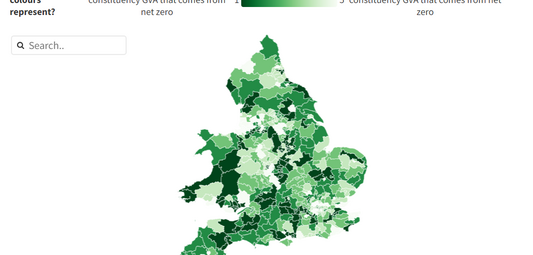We’ve worked alongside CBI to create a comprehensive mapping of the UK Net Zero economy; but what went into its creation?

First steps and methodology
Our work on Net Zero started quite a while ago when we were working with one of the big four accounting organizations on methods to map the Net Zero economy. While this research remained unpublished, it was pivotal in providing us with direction in our future endeavours.
The questions we needed to answer to start with were – what is the sector and what are its industry verticals? This is very important as it sets the foundation for the work going forward. Since there is no strict definition of what a Net Zero company is, we had to find a reputable source to pull our information from – for this we went to the Office for National Statistics (ONS).
Our Net Zero economy work is based off ONS’ Low carbon and renewable energy economy, UK research, so naturally, we draw heavy inspiration from it. With that being said, this analysis has been conducted in a very different way from our own. Their approach was survey based, the results of which can be seen below:
“The LCREE Survey was despatched for the sixth time in 2020, for the reporting year 2019, to a sample of 24,560 businesses. It achieved a response rate of 68% and of those responding, 2,331 businesses were operating in the LCREE sectors captured by the survey.”
Due to the difference in methodology, we had to adapt this research so we could use the readily available machine-learning (ML) in our platform.
Creation of the Net Zero RTIC
The starting point for mapping the Net Zero economy was to build out a Real-time Industry Classification (RTIC) for the sector using company information from available directories. For one of our industry verticals, we initially used the Renewable Energy Planning Database (REPD) – published by BEIS – to feed companies into a training set. This data source allows us a “wide catch” to try and help eliminate biases that our methodology might have.
One of the big challenges we faced was finding genuine renewable energy companies. Shell, for example, has a lot of information on their website relating to “clean energy”, however, they are far from being a Net Zero company. Due to this, as well as some other odd matchings, our data set required a manual review to make it as accurate as possible.
In some cases we were able to add subsidiaries of larger companies to our list such as EDF Energy Renewables, who had made a commitment to help Britain achieve Net Zero emissions by 2050.
The Net Zero RTIC today

It was after this initial list building that we published the first RTIC – with a URL accuracy of around the 80% mark. Since then, we have reviewed the RTIC (most recently being June 2022) which has improved the accuracy of the data. While the number of companies hasn’t changed too much (around 1000 difference), our URL accuracy has increased substantially. Today, it sits at around 95% accurate. A massive improvement!
Within our Net Zero RTIC we currently have 16 verticals, however since it can be hard to define what counts as a vertical, we are always open to being told that there are more. One example of this exact occurrence is when we conducted some research into the green economy with WPI Economics. In this research, we decided that green finance should be added into the Net Zero RTIC. Thus we adapted our understanding of the Green Finance industry and published it in the RTIC. The ONS doesn’t currently include this, but we perceive it to be important enough to be added to our RTIC.
Since we started mapping the Net Zero economy, we have continued to improve the data available for the companies within the RTIC – we have added investment data (Dealroom, InnovateUK, 360Giving), financial data and more. This allows us to analyse the sector in much finer detail and provides users of the platform with much more interesting and useful data.
From this point, our partners CBI Economics took our data and worked their magic on creating much of the report. We are very proud of the fact that CBI managed to very quickly and easily understand the data as this shows just how accessible the data we provide is. Since we already had the data as an RTIC within the platform, it meant we didn’t have to start from scratch which really sped up the process.
To find out more about our partnership with CBI Economics and our analysis of the Net Zero economy, make sure you read our blog post.
And if you’re interested in the full report, you can buy it now from our reports portal.


